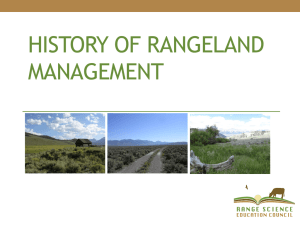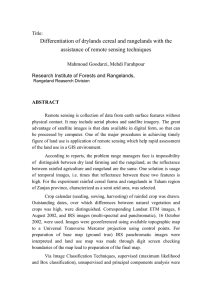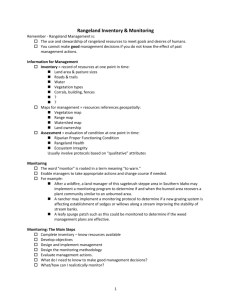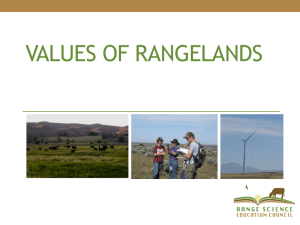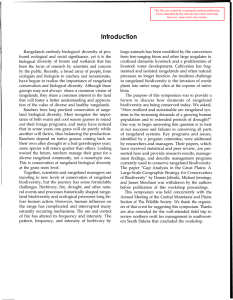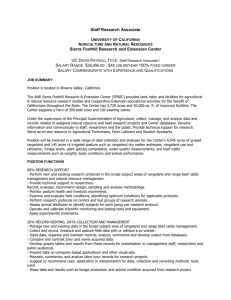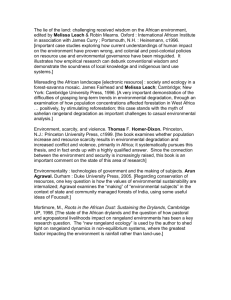Social and Economic Indicators of the Sustainable Rangelands Roundtable
advertisement
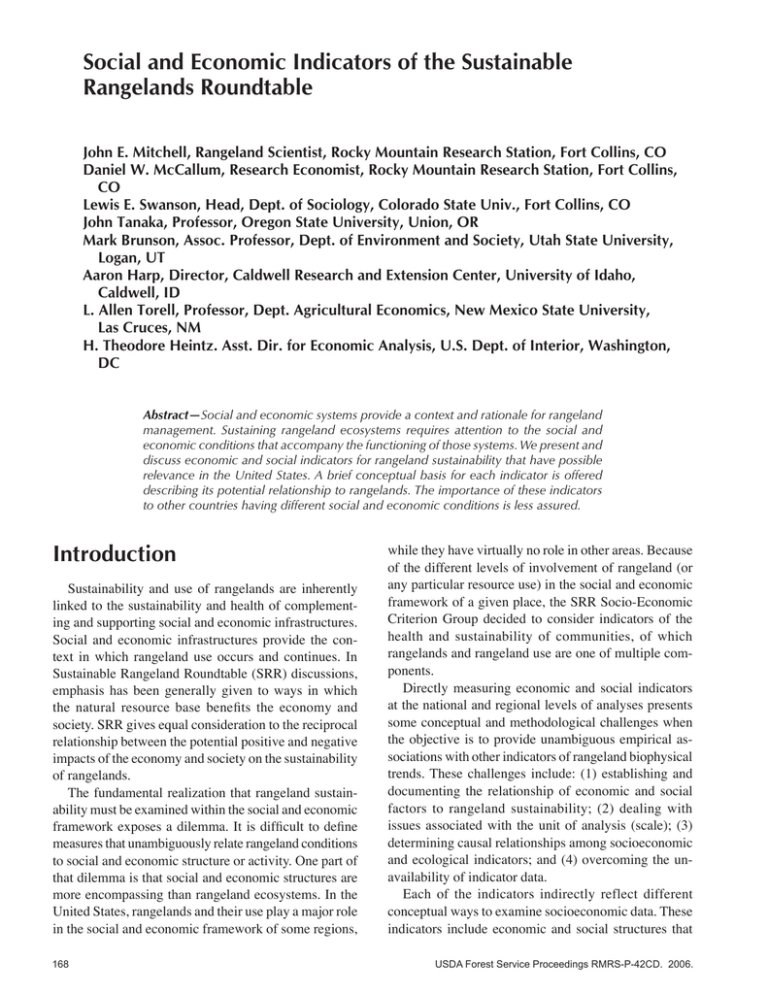
Social and Economic Indicators of the Sustainable Rangelands Roundtable John E. Mitchell, Rangeland Scientist, Rocky Mountain Research Station, Fort Collins, CO Daniel W. McCallum, Research Economist, Rocky Mountain Research Station, Fort Collins, CO Lewis E. Swanson, Head, Dept. of Sociology, Colorado State Univ., Fort Collins, CO John Tanaka, Professor, Oregon State University, Union, OR Mark Brunson, Assoc. Professor, Dept. of Environment and Society, Utah State University, Logan, UT Aaron Harp, Director, Caldwell Research and Extension Center, University of Idaho, Caldwell, ID L. Allen Torell, Professor, Dept. Agricultural Economics, New Mexico State University, Las Cruces, NM H. Theodore Heintz. Asst. Dir. for Economic Analysis, U.S. Dept. of Interior, Washington, DC Abstract—Social and economic systems provide a context and rationale for rangeland management. Sustaining rangeland ecosystems requires attention to the social and economic conditions that accompany the functioning of those systems. We present and discuss economic and social indicators for rangeland sustainability that have possible relevance in the United States. A brief conceptual basis for each indicator is offered describing its potential relationship to rangelands. The importance of these indicators to other countries having different social and economic conditions is less assured. Introduction Sustainability and use of rangelands are inherently linked to the sustainability and health of complementing and supporting social and economic infrastructures. Social and economic infrastructures provide the context in which rangeland use occurs and continues. In Sustainable Rangeland Roundtable (SRR) discussions, emphasis has been generally given to ways in which the natural resource base benefits the economy and society. SRR gives equal consideration to the reciprocal relationship between the potential positive and negative impacts of the economy and society on the sustainability of rangelands. The fundamental realization that rangeland sustainability must be examined within the social and economic framework exposes a dilemma. It is difficult to define measures that unambiguously relate rangeland conditions to social and economic structure or activity. One part of that dilemma is that social and economic structures are more encompassing than rangeland ecosystems. In the United States, rangelands and their use play a major role in the social and economic framework of some regions, 168 while they have virtually no role in other areas. Because of the different levels of involvement of rangeland (or any particular resource use) in the social and economic framework of a given place, the SRR Socio-Economic Criterion Group decided to consider indicators of the health and sustainability of communities, of which rangelands and rangeland use are one of multiple components. Directly measuring economic and social indicators at the national and regional levels of analyses presents some conceptual and methodological challenges when the objective is to provide unambiguous empirical associations with other indicators of rangeland biophysical trends. These challenges include: (1) establishing and documenting the relationship of economic and social factors to rangeland sustainability; (2) dealing with issues associated with the unit of analysis (scale); (3) determining causal relationships among socioeconomic and ecological indicators; and (4) overcoming the unavailability of indicator data. Each of the indicators indirectly reflect different conceptual ways to examine socioeconomic data. These indicators include economic and social structures that USDA Forest Service Proceedings RMRS-P-42CD. 2006. are generally associated with individual and community well-being. For example, measures of demographic structure, including age, gender, ethnicity, and social stratification, provide indirect indicators of population stability, as well as rates of change that can be assumed to indirectly measure individual and community well-being. The challenge is to establish the degree of association among these indicators that can be reasonably attributed to the relationship between ecosystem status and function and human activity. Even in regions of the United States that are predominantly characterized by rangeland ecosystems, the economic and social activities occurring on these landscapes may have limited direct impact on rangeland commodities, amenities, and ecosystem services. A rural community, for example, may be gaining in population because of attractive features that promote immigration by retirees while the number of people involved in production activities on rangeland is in decline. Or, where rural communities diversify their economic base, they often provide off-ranch employment opportunities that make it easier for economically marginal ranching operations to stay in business. Portraying the health and sustainability of economies and communities, and then associating those communities with rangeland regions, provides a more complete picture from which to evaluate rangeland sustainability. We concluded that the pragmatic way to address the lack of direct measures was to provide a minimum number of indicators that could describe key conceptual issues associated with economic and social activity. While this approach provides basic information, it will not be statistically adequate for detecting interaction effects among these variables. The issue of scale constitutes a persistent challenge. Given the local nature of social and economic structures, and the potential for diversity of economic and social conditions within any county, state, or region, the methodological problem of discerning measures of activities directly related to rangeland conditions at broader scales is problematic. Aggregating the scale of analysis to a national level can also mask relationships that would only show up at more local levels. In the United States, social and economic variables are frequently reported at the county level. The sampling units for these statistics are at a finer level, such as the individual, family, or household. Thus, in some cases opportunities may exist for spatial and temporal analysis below the county level. This is true of census data, where Topologically Integrated Geographic Encoding and Referencing (TIGER) system files make some analyses possible at the census tract (sub-zip code) level. We have adopted three groupings of indicators comprising a comprehensive perspective of sustainability within the larger social and economic context in which rangelands exist and use occurs. National Economic Benefits describes the types of products coming from rangelands and valued by society. Community Well-Being and Capacity seeks to define the value of community social and human capital in rangeland-dominated areas. Community-Level Explanatory Indicators That Might Be Relevant to Sustainability seek to understand how communities affect rangelands. Indicators within these grouping are considered in terms of their importance, geographic variation, scale, data sufficiency, and clarity to stakeholders. National Economic Benefits National Economic Benefits indicators monitor products and benefits derived from rangelands and rangeland use. The interpretation of these indicators can be meaningful at the national, regional, and local levels. The Value of Forage Harvested From Rangeland by Livestock Livestock grazing is the historical economic use of rangelands and it continues to be an important use on both public and private lands. Measuring the value of this use remains important to understanding a major economic and social benefit derived from rangelands. Collecting meaningful data on the value of forage harvested by livestock will not be trivial. Regional differences in the value of forage for livestock production exist. Private land lease rates are different by region. Total grazing costs (fee and non-fee costs) are highly variable with as much difference within regions as between regions. Grazing cost data are not collected and reported regularly. This indicator appears to be meaningful at multiple spatial and temporal scales. Differences in data and data trends are observed through time and with data collected at the state level. Values are expected to vary among and within states. However, given current national data collections, the scale most appropriate would be at the state level, although state-level estimates of private land lease rates are not valid at the state level except to measure general trends. Overall, methods and procedures exist for data collecting and reporting and data sets of useable quality exist at the regional-national level. While the procedures for forage valuation are accepted, their use is not always consistently applied. There are generally four methods that have been used to estimate forage value: private land lease rates adjusted for lessor services, competitive bid, replacement feed value, and marginal value analysis. Of these, the private land USDA Forest Service Proceedings RMRS-P-42CD. 2006.169 lease rate (unadjusted for lessor services) is the only one consistently collected on a national scale. Lease rates are reported on a dollar/head, dollar/animal-unit-month (AUM), and dollar/cow-calf pair basis. The data are repeatable and reasonably accurate. The survey data have been criticized for being based on hearsay and the small sample size collected by state. The average lease rate measures both the forage value and the value of leasehold services provided by the lessor. No attempt is made in this data set to arrive at only the forage value for either private or public lands. Once we are able to establish a forage value, total forage value can be estimated when total AUMs from rangeland are determined. The finest level of detail given current reporting of average lease rates would be at the state level, but there is some question whether data are reliable when disaggregated to that level. The value of forage used by livestock is understandable and interpretable through time and space. In its current form, however, few stakeholders understand that it measures more than just the value of forage. This must be relatively constant over time if trends are to be monitored. Value of Non-Livestock Products This indicator monitors the economic value of products produced from rangeland that are not related to livestock production, including recreation, scenic views, nature experiences, open spaces, and so on. Rangelands produce more than just livestock and wildlife. The value of these non-livestock outputs is important for recognizing the diversity of outputs produced from rangelands. The combination of non-livestock products of interest to stakeholders and those that can be monitored through time needs to be identified. Once that combination is known, values can be derived through a variety of market and nonmarket valuation techniques. Data availability will depend upon the specific products and services chosen to be monitored. Some data may exist for non-livestock outputs on federal lands and state trust lands, but we know of no data sources for private lands, some of which may be proprietary. A few wildlife species in specific situations have been evaluated for their values using both travel cost and contingent valuation methodologies with varying availability and scope. However, for the most part, no data exist. This indicator will only be understood by the public if the set of non-livestock rangeland outputs to be valued is defined. Stakeholders understand dollar values. Some care must be taken to ensure that the dollar values derived through various nonmarket valuation techniques are comparable to those determined in the marketplace. 170 Number of Visitor Days by Activity and Recreational Land Class This indicator is a measure of the amount of recreation use on rangelands. It has relevance to sustainability as a measure of benefits from recreation. Recreational land classification into primitive areas, roadless areas, open public land, private lands, and other types provides one possible basis to compare the types of recreation and how those change through time. With the exception of national parks and monuments that draw visitors from around the world, rangeland recreation use is generally highest at sites that are relatively close to population centers. There are also regional variations in the popularity of various outdoor recreation activities, such as hunting and hiking. USDA Forest Service monitors recreation use by type of location (day use developed sites, overnight use developed sites, wilderness, other National Forest System land use, and viewing from corridors). Some data set(s) exist at the regional-national level, but methods and procedures are not standardized. There are two problems associated with recreation use monitoring. First, different land management agencies use different measures and obtain data in different ways, although the lack of consistency will decrease somewhat when the Forest Service and Bureau of Land Management (BLM) switch to a “visitors” measure instead of the current “recreation visitor-days” measure (an RVD is 12 person-hours, a measure that is more valid because it better accounts for duration of use, but has proven too difficult for the multiple-use agencies to measure over extensive landscapes.) Second, these measures are not tied to land types but to ownerships. There is not a good way to aggregate use data from multiple agencies, although the Forest Service attempts to estimate use across ownerships in its periodic RPA assessments. Reported Threats to Quality of Recreation Experiences This indicator is envisioned as a way to address a problem inherent in recreation use; i.e., rangeland health is influenced by the physical and social impacts of recreation use, and these impacts are not necessarily correlated with user density. Biophysical impacts of recreation typically follow a curvilinear pattern where marginal changes, such as soil compaction, become smaller as use levels increase. Therefore, changes in visitor numbers may or may not indicate loss of value at the site level, depending on whether use is already low, moderate, or high. Social impacts of recreation, like crowding and conflict between user USDA Forest Service Proceedings RMRS-P-42CD. 2006. groups, are more dependent upon characteristics of the use and users than on simple numbers of users, although the potential for conflicts between users increases with the number of users. Accordingly a useful indicator of recreation value should account for quality of use as well as quantity. One way to do this would be to create a composite index. Such an index could address trends in crowding complaints by recreationists, levels of conflicts among recreation user groups, and depreciative behaviors (vandalism, rule violations, etc.). There is also the need to develop quantitative data related to physical features (for example, road density, trails, home densities) to complement the subjective information provided by managers and put it in context. Standardized methods and procedures for data collecting and reporting exist at the regional-national level, but useable data set(s) do not exist at the regional-national level. In particular, no index of quality of recreation use has been devised. The method is technically feasible, easily aggregated, interpreted, and repeated using standard survey protocols. Measures are subjective so there will be random error associated with differences in the perceptions of persons completing the questionnaires; however, there is no reason to suspect systematic data biases. Value of Investment in Rangeland, Rangeland Improvements, and Recreation/Tourism Infrastructure This indicator monitors expenditures on new and existing structures and similar inputs for a variety of uses. It is the amount agencies and individuals actually spend on infrastructure for any given use of rangelands. It would be useful if data could be found to differentiate between public investment, private investment, and cost sharing. The indicator should depict how much the current generation is willing to invest in maintaining current usefulness of the resource base for a variety of uses. Investment explicitly implies that funds are being expended to obtain future returns from productive rangeland uses. Productive rangeland uses include more than just livestock production. A value of investment indicator is conceptually feasible, but no regional-national methods, procedures, or data sets currently exist. U.S. federal agencies reports on units and dollars spent annually for range improvements. Some data for private lands may be available through Natural Resources Conservation Service and some of the USDA subsidy/cost-share programs. It may also be possible to develop a data collection protocol where none exists by using a standard survey. Rate of Return on Investment for Range Livestock Enterprises This indicates whether ranch families are making a competitive rate of return on their investment from producing livestock on rangelands. If the rate of return on rangeland-based livestock operations is not competitive, it means that other forms of returns are important, other sources of income are important, or that the ranch is likely to be converted to other uses. Data to monitor returns on rangeland investments are conceptually feasible or initially promising, but no regional-national methods, procedures or data sets currently exist. In the United States, western universities periodically prepare cost and return estimates for range livestock operations at the county, region, or state level. Although standardization is improving, methodological differences exist across institutions and researchers. All geographic areas are generally not updated annually, and many cost and return studies are only done every five to 10 years. Some states have no information. The USDA Economic Research Service (ERS) makes cost and return estimates at the national scale using surveys conducted every five to eight years for each commodity. USDA Livestock budgets are defined across wide geographic areas. Livestock cost and return estimates consistently show that livestock producers are not currently and have not in the past made a competitive rate of return on investment. Ranches are overpriced relative to the value of the livestock produced. Livestock is the only product considered in the cost and return series. For data to be useful, new data sources will have to be initiated. These data would need to use similar accounting procedures and valuation of opportunity costs. It would have to be done in a timely manner. Because land appreciation is a major long-term return from ranch ownership, this variable must in a site specific way). Number and Value of Conservation Easements Purchased This indicator would measure the number of conservation easements and/or the number of acres protected under conservation easement. This is an indicator of the presence and trend of open-space, and acts as a measure of amenity availability. It speaks to the desirability, adaptability, and resilience of communities, and the community perception of the importance/value of that land use. Methods and procedures exist for data collecting and reporting; and data sets of useable quality exist at the regional-national level. Data are compiled by various land trusts and conservation groups and reported centrally to the Land Trust Alliance (LTA) at http://www.lta.org. USDA Forest Service Proceedings RMRS-P-42CD. 2006.171 The LTA compiles information about conservation easements by state. Data on the number and size are collected from surveys with known groups doing land trusts and conservation easements. USDA ERS also reports upon the extent of land trusts in the United States. Expenditures (Monetary and In-Kind) on Restoration Activities This indicator measures the amount of funds that organizations and individuals contribute to rangeland restoration activities. It indicates the strength of importance people place on restoring rangelands. These expenditures are made to maintain, enhance, or restore the rangeland ecosystem without explicit monetary future returns expected from the investment. No regional or national methods, procedures, or data sets currently exist for monitoring restoration expenditures. Some data are available at local levels by agency or organization; however, costs for rangeland improvements on private lands are nearly always proprietary. The Threat or Pressure on the Integrity of Cultural and Spiritual Resource Values This indicator measures the intensity of concern and pressures for management. Cultural and spiritual resources are assets valued by all sets of people. The indicator is important because it assesses the status of a characteristic of rangelands valued by people and protected by federal law. We assume that, when spiritual or cultural values are threatened by activities on rangelands, citizens will suffer loss of value from those rangelands, and may act to protect those values in ways that decrease the value of other resources; for example, by restricting livestock grazing or recreation access. This indicator is conceptually feasible and promising, but no regional-national methods, procedures, or data sets currently exist. Any measures will be subjective so care must be taken to ensure against bias of any kind in the estimates. Aggregated data should be reliable if sufficient responses are obtained on a regular basis. Despite the legal protection afforded to cultural/spiritual resources, there currently is no regular, large-scale effort to monitor their status. Community Well-Being and Capacity Indicators in this Section are intended to portray social structure. When measurements are made at 172 anything larger than a community level, they begin to lose meaning when the appropriate theoretical concept is a community or other local unit of social organization. In the United States, county-level data provide insights of social structure, thus giving a reasonable approximation of local socio-economic trends. Poverty Rate—General USDA, in cooperation with other federal agencies, sets the poverty rate at the level where one-third of the household budget or more is going to food. It is assumed that any household that spends one-third of its budget on food is unlikely to be maintained at a minimal quality of life. This general poverty rate is a gross measure of social stratification that indicates the level of poverty within a county, and is indicator is needed to interpret interaction effects with other indicators. Methods and procedures exist for data collecting and reporting and data sets of useable quality exist at the regional-national level. Data are collected and reported as part of the U.S. Census of Population. Poverty Rate—Children This is a ratio of persons less than 17 years of age who live in households determined to be at or below the poverty threshold. It measures the proportion of children in poverty. Higher rates are associated with lower integration into the community and the higher likelihood of undesirable outcomes like reduced health, human capital, and social capital. This indicator is needed to interpret interaction effects with other indicators. Methods and procedures exist for data collecting and reporting; and data sets of useable quality exist at the regional-national level. Data are collected and reported as part of the U.S. Census of Population. Income Equality This indicator measures the extent to which income is equally distributed among households in the economy. It addresses economic distribution and equity. It indicates the general welfare of the community by looking at the distribution of people across the range of incomes. It is a direct measure of economic and social stratification. Equality levels are positively correlated with other measures of community cohesion or integration. Methods and procedures exist for data collecting and reporting and data sets of usable quality exist at the regional-national level. Data are collected at the county level and this is the most useful scale. The use of Gini coefficients to measure income equality is one standard method. Such coefficients are available at web sites such as http://www.unc.edu/~nielsen/data/data.htm. USDA Forest Service Proceedings RMRS-P-42CD. 2006. Index of Social Structure Quality Social science literature often addresses the multidimensionality of concepts that are being measured using indices – the adding together of multiple indicators to create a single broad based measure. These indices are subject to the same rules of validity and reliability as the data upon which they are based. The quality of social structure could include access to and quality of medical care (for example, per capita hospital beds, physicians, nurses), presence of cultural community services, public recreational facilities (expenditures per capita), and crime rates. This is an indicator of the capacity of communities to address the quality-of-life and may indicate their willingness to address environmental issues. Standardized methods and procedures for data collecting and reporting exist at the regional-national level, but useable data do not exist at the regional-national level. The base data are available, but no specific index has been developed. It is imperative to recognize here, as well as other places where indices are proposed, that indices can hide countervailing influences. Thus, increases in one component can cancel out decreases in another. Also, while indices can simplify the presentation of or results to non-specialists, they can bury political and other biases, thus allowing more benign but deceptive labels. In general, it is very difficult to keep indicators politically and ethically neutral, such that they don’t favor some groups over others. Community Satisfaction This indicator measures the degree to which the local community feels about sustaining local resources and attitudes that contribute to a social foundation for acting to achieve stability over the long-term. This indicator is hypothetical at this point, but could provide useful information on how communities feel about natural resources. Methods and procedures exist for data collecting and reporting; and data sets of useable quality exist at the regional-national level. In the United States, the National Opinion Research Center collects data that may be useful. However, data improvements are greatly needed for this indicator to be viable. Federal Transfers by Categories (Individual, Infrastructure, Agriculture) Federal transfer payments (for example, food stamps, social security, Medicare/Medicaid, Forest Service payments-in-lieu-of-taxes, crop loans, crop subsidy payments, emergency livestock feed payments) are relatively stable sources of income to individuals and local governments during most economic conditions. The indicator measures another aspect of economic resiliency and capacity to endure changes in economic condition. Methods and procedures exist for data collecting and reporting and data sets of useable quality exist at the regional-national level. The U.S. Department of Commerce, Bureau of Economic Analysis, Regional Economic Information Service, reports upon these data for counties, states, and the Nation as a whole. Presence and Tenure of Natural Resource Non-Governmental Organizations at the Local Level The presence of private sector non-government organizations (NGOs) is considered to be an indicator of professional administrative capacity for managing community projects relating to rangeland sustainability that otherwise would be unsupported by government agencies. It is also an indicator of how strongly such groups feel about the importance of natural resources in an area. The indicator is conceptually feasible or initially promising, but no regional-national methods, procedures, or data sets currently exist. A comprehensive data set would require collaboration among various NGOs, including land trusts, involved in rangeland management and stewardship. Sources of Income and Level of Dependence on Livestock Production for Household Income This indicator measures the dependence of ranch families on livestock production for household income. Recent surveys have shown that few U.S. ranchers rely totally on the ranch for family income. Measuring the livestock component of disposable income and the percentage of ranchers highly dependent on livestock for income are both potentially useful measures. Higher dependence on ranch income may be correlated with grazing intensity during droughts, and the associated ability to follow sustainable grazing practices. Useable data sets do not exist at the regional-national level. Data sources are available for components of the questions about dependency on livestock production for household income. Some data may provide an indication of level of dependency. However, the data collection interval is problematic. Census of Agriculture data are collected every five years and do not distinguish between farms and ranches. The Agricultural Resource Management Survey data base may be another potential USDA Forest Service Proceedings RMRS-P-42CD. 2006.173 source but these data are collected at different intervals. The Census of Agriculture reports on operator characteristics. Three reported characteristics could be useful for this indicator: (1) On farm operated versus not on farm operated; (2) Operators by principal occupation, Farming versus other; and (3) Operators by days worked off farm, broken down by day categories. Data are not available specifically on the level of income dependency on livestock production from any known source on a consistent basis. Employment Diversity An Economic Diversity Index would respond too the number and size of industries/sectors present in an economy. It is typically measured in terms of employment. We think that economic diversity is related to economic resiliency and the ability of an economy to respond to and adapt to changes in conditions. Methods and procedures exist for data collecting and reporting and data sets of useable quality exist at the regional-national level. The U.S. Census Bureau collects this information as part of the Economic Census Data. Changes from Standard Industrial Classification (SIC) to the North American Industrial Classification System (NAICS) makes comparisons over longer time periods difficult. Only national and state level SIC and NAICS data can be compared. In the United States, economic diversity indices, using the Shannon-Weaver entropy function, have been computed for all U.S. counties, labor market areas, BEA functional economic areas, BEA component economic areas, and states using IMPLAN employment data. Agriculture (Ranch/Farm) Structure This is a multi-faceted measure of direct production in agriculture. In the United States, a farm or ranch is defined as having $1,000 or more in gross annual agricultural sales. Other facets of this indicator include type of commodity raised, acres in production, categories of farm sales (measure of scale), and the business organization (for example, individual, partnership, corporate). Farm structure is an indirect indicator of production capacity for food and fiber. It has become a data point for different perspectives to assess whether or not production can be sustained. There is not broad agreement on how the data might be interpreted, but there is agreement that these data are the basis for assessment. Methods and procedures exist for data collecting and reporting and data sets of useable quality exist at the regional-national level. Potential sources of data are provided by USDA National Agricultural Statistics Service and USDA ERS. 174 Years of Education This indicator measures the years of formal education of a population. It is an important measure of the human, and to a lesser extent the social, capital available for sustaining social groups and communities. Data are collected by both census enumeration and through the Current Population Survey. Community-Level Explanatory Indicators that may be Relevant to Sustainability Indicators in this Section are the likely to be directly tied to rangeland sustainability. They describe the population and conditions in local areas in ways that are conceptually linked to good rangeland use and stewardship. They also attempt to capture some of the underlying beliefs and attitudes in local areas relevant to the way people relate to, and interact with, natural resources in general and rangeland in particular. They are linked to sustainability with uncertainty because the linkages are neither documented nor unambiguous. Establishing some of the specific linkages between the indicators and rangeland sustainability is a subject for continued research. Value Produced by Agriculture and Recreation Industries as Percent of Total Economy Agriculture and recreation based industries appear to be the two important sectors of the economy related to rangeland sustainability. While neither occurs exclusively on rangelands, their trends in rangeland-dominated counties should respond to pressures being placed on rangelands, particularly as population densities increase and economies change. Methods and procedures exist for data collecting and reporting and data sets of useable quality exist at the regional-national level. While both data and methods are available, the linkage between the data and sustainability measures needs to be strengthened. In the United States, data are available from the U.S. Census Bureau. Employment, Unemployment, Underemployed, and Discouraged Workers by Industrial Sector This indicator provides information on the vitality of the local economy. High relative percentages in the unemployed, underemployed, and discouraged categories indicate an economy in trouble. Underemployment USDA Forest Service Proceedings RMRS-P-42CD. 2006. occurs when one is employed, but at less than the desired level; that is, employed part time when full time employment is desired. Discouraged workers are those who are unemployed and no longer actively looking for employment. High proportions of such workers in rangeland-related industries (for example, livestock production, recreation, tourism) may signify decreased health and vigor of rangeland related activities. Such changes would indicate how society was demanding uses from the rangelands and how such demand was being supplied. Methods and procedures exist for data collecting and reporting and data sets of useable quality exist at the regional-national level. Land Tenure, Land Use, and Ownership Patterns by Size Classes This indicator measures changes in ownership, such as public vs. private and production agriculture vs. exurban development, ownership stability, and land use. It is important to sustainability because land use changes have been shown to have multiple effects on rangelands (for example, loss of open space, habitat fragmentation, and noxious weeds). Land use changes also can limit future options for the land. The indicator seems conceptually feasible or initially promising, but no regional-national methods, procedures or data sets currently exist. Most relevant data come from the quinquennial Census of Agriculture and the Agriculture Economics and Land Ownership Survey. However, data are not reported in a form meaningful to this indicator. Sales classes rather than tract sizes report ownership and tenure data. One of the problems appears to be that neither the Census nor USDA currently sorts the data by tract size. Population Pyramid and Population Change Population pyramids are the most common descriptor of population structure. It requires actuarial data on gender and age. Data are organized into five-year age cohorts. Each population pyramid provides a snapshot of the distribution of age groups and gender. For example, the baby boom cohorts between 1945 and 1960 have bulged out as they moved up through the population structure. This measure directly provides evidence of community sustainability. A population pyramid that varies little from the youngest to the oldest cohorts is considered to be stable. The proportion of population in different age classes can be informative; for example, very young or very old age structures indicate differing needs with respect to social and economic goods and services, some of which are derived from or associated with rangeland activities. This indicator would measure changes in components of the population between base years, probably U.S. Census years. Births, deaths, and net migration patterns are also important components to understand population change in a community. Some changes in population structure are associated with different pressures on land, water, and fiscal resources. Methods and procedures exist for data collecting and reporting; and data sets of useable quality exist at the regional-national level. Income Differentials from Migration This indicator measures the differentials between existing household income in an area and household income of in-migrants. It addresses whether the people moving in are wealthier than those already there. Retirees or the wealthy do not usually rely on local natural resources for livelihoods in the same fashion as long-time residents. Methods and procedures exist for data collecting and reporting, and data sets of useable quality exist at the regional-national level. Data are available from U.S. Census population reports, the CIESIN population dataset for migrations, and the LANDSCAN dataset. County-to-county migration files that directly measure household income from current residents, out-migrants, and in-migrants by county are available from Internal Revenue Service data sets. Length of Residence (Native, Immigrant More Than 5 Years, Less Than 5 Years) This indicator measures the years of residence in a particular community and relates strongly to social cohesion/integration and willingness to interact with others for a common good. This indicator is also a measure of economic stability. Methods and procedures exist for data collecting and reporting and data sets of useable quality exist at the regional-national level. The Census of Population and the Current Population Survey collect data on tenure of residence for households. The primary question is whether or not a person has lived in a place for less than five years. Income by Work Location versus Residence This indicator relates to whether income is generated where one lives or from outside the area of residence. It should relate to the importance of the residence USDA Forest Service Proceedings RMRS-P-42CD. 2006.175 communities, both economically and socially, to the income earner. It measures whether rangelands are providing the desirable rural setting where people want to live, but without the employment opportunities they require. Methods and procedures exist for data collecting and reporting, and data sets of useable quality exist at the regional-national level; for example, location adjustments in the Regional Economic Information System produced by the Bureau of Economic Analysis and the journey-towork data from Bureau of the Census. Public Beliefs, Attitudes, and Behavioral Intentions toward Natural Resources Public beliefs, attitudes, and behaviors influence cultural, legal, and public policy decisions toward the management, consumption, and preservation of natural resources. In order for rangeland management decisions to be socially sustainable (especially on public lands), they must achieve and retain some minimum threshold of social acceptability. This indicator would provide for regular measurement of preferences, attitudes, and intentions with respect to rangelands. Social science research indicates that a person’s behavior in political and planning arenas is influenced by his/her beliefs, attitudes, and behavioral intentions. Comprehensive data sources for this indicator are generally not available. Some data sets exist at the regional-national level, but methods and procedures are not standardized. In the United States, the National Opinion Research Center maintains data sets, but they do not presently assess rangeland-related issues. Some national-level studies have evaluated public beliefs and attitudes regarding federal rangeland management and analyses included regional comparisons, but they have not been repeated through time. Methods and survey instruments from such studies may be modified for periodic re-sampling, although additional information would need to be gathered on issues not considered in the original studies. 176 Conclusion Our development of indicators for the social and economic benefits criterion has focused upon three levels. The first emphasis was on the products derived from rangeland ecosystems that are used by communities. Second, we focused on the communities themselves and how they react to what is happening in the larger ecosystem. Finally, we tried to examine whether what is happening in communities is having an impact on surrounding rangeland ecosystems. In order for this approach to be useful, we reiterate that data reporting must be made at the rangeland county level. In order to be helpful in policy discussions, we need simple, yet comprehensive, composite indices of socioeconomic conditions that can be portrayed in understandable ways. Perhaps, a remaining task is to develop a composite index for each of the three primary groupings. While all the background data associated with the complete set of indicators is developed and considered, it is the next step to offer information to the policy discussion with an answer to the “so what?” question. While we have not taken this step at this point, failing to do this task only delays the inevitable and leaves one with a false sense of security associated with the sustainability discussion. In closing, we believe that much of the data needed to assess this criterion are currently available. Indicators in the first grouping, National Economic Benefits, have the weakest link to adequate data; only two have good, existing data while two others have partial data. Taken as a whole, the set of indicators should provide information that can be used to assess the social and economic benefits derived from the Nation’s rangelands. How this information is integrated with the ecological and legal information into a coherent statement of sustainability remains to be seen. The issue still remains whether data can be disaggregated to the level that is relevant to rangeland dependent community sustainability. USDA Forest Service Proceedings RMRS-P-42CD. 2006.
